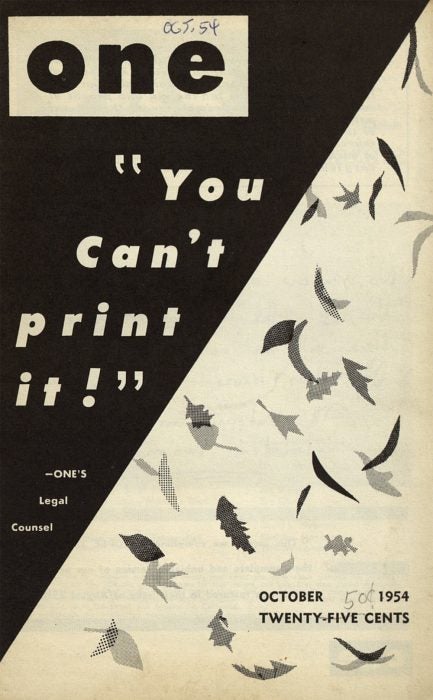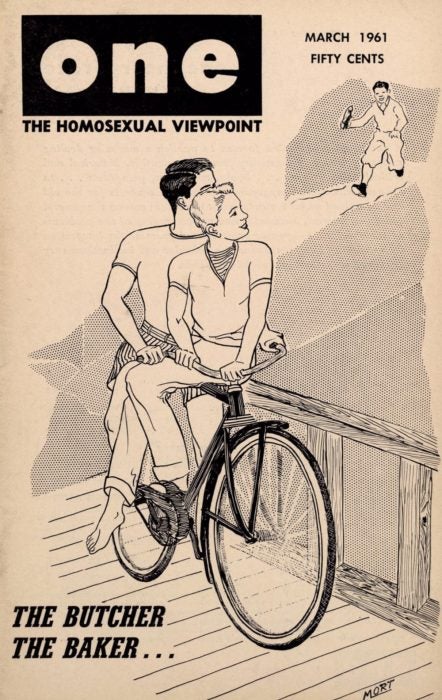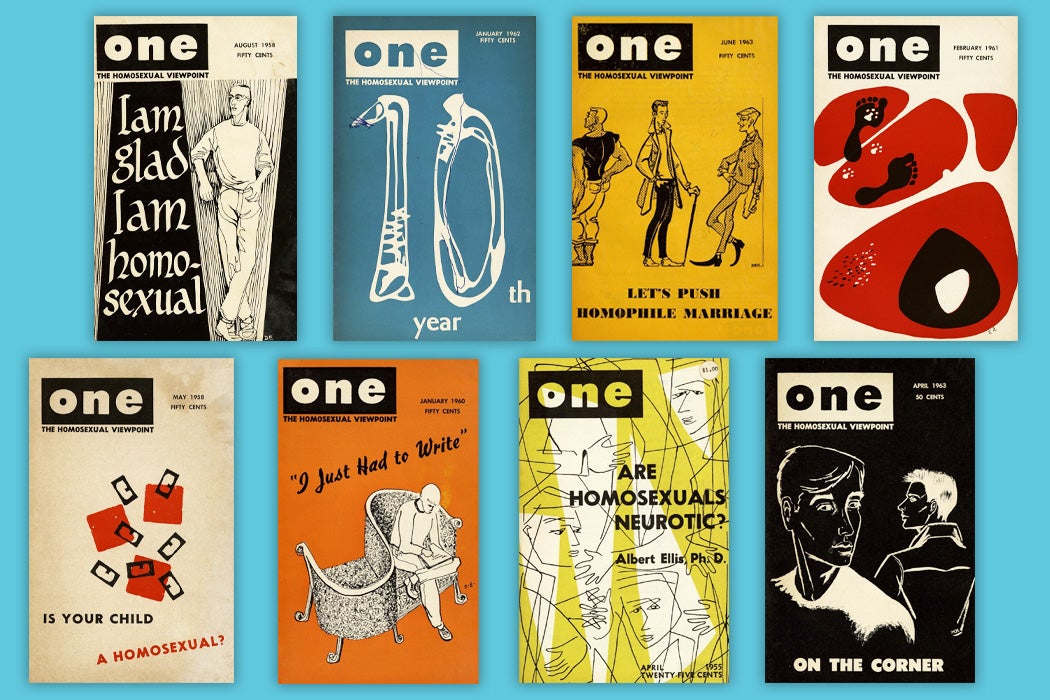ONE, Inc., was one of the first gay rights organizations in the United States. It was founded in Los Angeles in 1952 with money and leadership from U.S. groups like the Mattachine Society and the Daughters of Bilitis, as well as Swiss magazine Der Kreis. That same year, a 7.2 earthquake shook Southern California along the White Wolf Fault, and the Emmys were awarded to shows made across the U.S. for the first time (before that, the awards just went to L.A. studios). Lucille Ball and Desi Arnaz hosted the show from the Cocoanut Grove Lounge. The following year Dwight Eisenhower issued Executive Order 10450, which said gays and lesbians were perverts, criminals, mentally ill, and must be blocked from any kind of federal employment. So much was hopeful, but at times everything felt broken and hopeless too. The digital archive of ONE, the monthly magazine published by ONE, Inc., reflects the contradictions of the time. It’s a record of endurance, legal and emotional labor, new and inherited trauma, tenderness, and joy.
The magazine was mailed internationally in unmarked brown envelopes. For safety and longevity, ONE’s all-gender board of editors often used pen names, and always depended on other jobs for food and rent. Even so, within a few months of the first ONE, the FBI identified everyone and wrote their employers, calling all staff “deviants” and “security risks” in a middle-school-style attempt to destroy health and security. Luckily, the employers largely ignored the notices, which surprised the FBI so much they shifted public attention elsewhere, for a while. Come 1953, however, the Post Office froze an issue about homosexual marriage for three weeks before officials in Washington, D.C. demanded that distribution proceed. (Maybe someone politically powerful somewhere was missing their magazine.) That issue went out, but its delay caused a dip in finances that meant August and September 1954 were never printed, and subscriptions were extended.
Weekly Newsletter
The October 1954 issue of ONE featured six “You Can’t Print It!” rules, in an attempt to chill both the Post Office and readers who said the magazine was too tame. The rules were also codes. Consider rule #4: “Descriptions of experiences which become too explicit, i.e. permissible: ‘John was my friend for a year.’ Not permissible: ‘That night we made mad love.’” Today that rule seems like a wink, and maybe it did then, too. Maybe it also projected some readers into a luminous, disembodied ache. Other rules showed how obscenity along a binary (i.e., either X is obscene, or it isn’t) nearly always risks shame in its wake. A good example can be found in rule #5, which said ONE wouldn’t print “descriptions of homosexuality as a practice which the author encourages in others, or waxes too enthusiastic about.” In an era when pride is consistently messaged as brave, normal, and good, it’s important to remember the limits of words without action, but also how radical ONE was for simply stating the rules it couldn’t break, if it wanted to be in the mail. Plus, as Douglas M. Charles writes in “From Subversion to Obscenity,” in this way ONE began to challenge the F.B.I.’s “strategy for silencing the homophile movement by prosecuting it as a purveyor of smut.” The risqué cover of this ultimately particularly deviant issue? About thirty fall leaves, tumbling on a diagonal in low-resolution.

ONE fought just one of many fights for visibility (which is one step towards acceptance, which is the first step towards health and security), that have happened, are happening, and will happen in this country. These battles can be sexy from an aerial view, but on the ground, they’re often also exhausting and violent. It’s stunning, now, to have a resource that so plainly documents the spiral and compromise of a long fight, down to advertisements from gay European magazines and hints at genuine intersectional support, for example the occasional appearance of Marvin Edwards, a Black accountant who was the lover of ONE co-founder W. Dorr Legg. (Both were connected to Knights of the Clock, a social club open to Black and white cis gay men. Edwards sometimes used the name Merton L. Bird.) However, it’s still easy, now, to discount chunks of ONE magazine as tepid white moderate takes. Does understanding matter when you’re still blocked from housing, work, and medicine? At these times, ONE’s consistent transparency is equally admirable. There are contradictions in its pages, which means they echo life.
That was just the first year. The L.A. Post Office seized the October 1954 issue as a violation of the 1873 Comstock Act, which criminalized sending porn, sex toys, contraception, or abortion tools through the mail. ONE’s first three “You Can’t Print It!” rules—1) no lonely hearts ads, 2) no cheesecake, and 3) no description of “sexual acts or their foreplay”—did follow Comstock, however archaic it was, but the issue also featured a short story called “Sappho Remembered,” pajama ads, and a poem including this couplet: “Some peers are seers but some are queers / And some boys WILL be girls.” Like Grandpa said, “Do as I say, not as I do.” ONE lacked money to sue the Post Office (likely also the time—they had the next issue to publish!), and so they asked Eric Julber, the straight young lawyer who drafted those six rules, to take the case for free. He did, and lost in Federal District Court as well as the Court of Appeals before a January 1958 victory in the Supreme Court. The verdict was simple, and merely prevented the Comstock restrictions from affecting the written word. While some see this case as the first time homosexuality was ever addressed at that level of the courts, others say it wasn’t a civil rights victory, just a loophole built so people could keep reading porn. Both views make sense. ONE continued to be significantly harassed by the U.S. post office and customs, but it was now legal.
And the magazine kept publishing until 1967. The organization’s name came from Thomas Carlyle, a British thinker who was anti-democracy and very likely pro-nazi. In 1849, he wrote an essay arguing for slavery and indentured servants. But he also wrote about “a mystic bond of brotherhood [that] makes all men one,” and that became ONE’s name and compass. The disembodiment allowed by a “mystic bond” was no doubt in part meant to dodge anti-obscenity laws, but by focusing on a belonging connected to normalization through not the heart, but the brain, ONE also oriented itself towards institutional acceptance. It isn’t necessarily wrong, at all, to want that kind of stability, but it can be violent to assume that everyone wants what you do, and can have it if they would just focus, and wait. In ONE’s pages, sometimes this dynamic is communicated with the urgent noise of real-world complications, sometimes with the violent quiet of trauma, and sometimes it’s baroque like a Smiths song (“William, it was really nothing”).
On the first page of ONE’s first anniversary issue, which is also the first edition available through JSTOR, the magazine stated that “ONE does not claim that homosexuals are better or worse than anyone else, that they are special in any but one sense.” This one sense, which ONE is “devoted to correcting” through “scientific, historical, and critical points of view,” is that gay people are not citizens. The line from here to “Don’t ask, don’t tell” is direct. The one to “We’re here, we’re queer, get used to it” is here too, but it drifts.
Significantly, the majority of ONE writers fought for visibility while also decentering themselves. One frequent refrain throughout these pages is an invitation that rings sincere. “Your manuscripts, contributions, and work are welcomed. ONE is entirely yours.” What a powerful final line—not “you owe us,” or “let us know what you want to read!” but “we’re yours.” And it was true—in part because it could be, at a time when print media ruled and blossomed, but also because readers made it so.
Each issue of ONE had four main sections: Articles (mostly related to citizenship or belonging through law, religion, or community), Fiction (mostly about people whose hearts and brains want “love forever and pink clouds and US,” only their bodies are stuck), Poetry, and Departments. The latter is the most alive in time, so it’s the most exciting reading too: letters from the editors, book reviews, mostly anonymous letters, and a Tangents section containing DIY news reports from readers (often with heavy clarity, for example an obituary for Yale Younger Poet Edgar Bogardus, who died of carbon monoxide poisoning). Because ONE was for the people, by the people (as opposed to for the people, strained through a single funder), there are contradictions. There are judgy rhetorical questions (“Can homosexuals organize?”), hypermasculine asides (“Do you have the guts?”), and not-okay amounts of teenage butts, but also letters from India, a caring if psychologically dated column by Dr. Blanche M. Baker, articles for and by intersex and trans people, and consistently vulnerable sincerity.

On the whole, ONE does actively work to be intersectional, but because its authors were largely white and middle-class, despite the obvious prejudices gay Americans faced during these times in particular, there are still some tone-deaf moments. A 1965 profile of “an American Indian homosexual named Elmer Gage” goes to Elmer in Colorado, publishes significant oral histories, and is aware of its otherness, and a 1959 “Report from New York” side-eyes Jack Kerouac’s “rather desperate concern” over his masculinity, but that same article also calls Frank O’Hara “disappointingly scatological,” and does not stop. “We would all like to take such things naturally as dogs in the street do, but it isn’t always appropriate to the occasion, and worse, is usually a great bore.” The author might just have been jealous.
Due to the focus on citizenship, ONE features especially extensive articles and case studies concerning marriage and war, especially the draft and police, who are called “the new Nazis” in a 1963 issue that also celebrated the 1957 Wolfenden Report, which stated that “homosexuality cannot legitimately be regarded as disease, because in many cases it is the only symptom.” “The New Nazism” focused on the summer of 1959 in New York, which featured blackouts, violence, and as Allen Ginsberg wrote in the Village Voice, “great exaltation, despair, prophecy, strain, suicide, secrecy, and public gaiety among the poets of the city.” James Kearful, the article’s author, wrote that the police, “naturally, are not the least bit interested in enforcing justice. They are interested in mollifying the public and keeping their jobs.” He connects this to increased American arrogance and surveillance, particularly in public restrooms, saying with scorn that “this is ‘modern,’ and this is frightening.”
Kearful also criticizes homosexuals for not fighting back, and says “the Negro has won civil rights in the last few years” [sic on all counts], “not because the United States Government is freedom-loving and benevolent (which it is not) but because through agitation, sacrifice, and organized effort, Negroes have forced society to recognize them and give them their rights.” On the one hand, it’s very hard to understand how anyone could read 1963 as a solid victory for Black Americans—that’s the year George Wallace physically blocked the entrance to the University of Alabama, Medgar Evers was killed, the 16th Street Baptist Church was bombed, and Malcolm X gave his message to the Grass Roots while Robert Moses continued tearing up the Bronx; the list goes on—but on the other, this is slightly less violent than not mentioning Black America at all, or with disgust, as so many publications of the time did.
Two years later, the Watts Riots occur in Los Angeles and ONE has changed its tone. In the editorial letter, not a separate article, Richard Conger writes: “The point is, let it never be forgotten, that whether we refer to slave masses in Ancient Athens, toiling peasants under the Manchus, grimy colliers in the 19th Century English Midlands, or to the underprivileged Negroes of Watts, no substantial sector of society can forever be kept in meek subjection. Human nature just is not like that.” He then takes a complicated step backwards, stating that because “the Homophile Movement represents another sort of revolt,” “such eruptions” will “never be necessary,” as many magazines now “freely publish homophile views,” and the wave of social change underway assumes “no Watts explosions are going to be needed, or likely to occur.” If mirrored visibility is the goal, then Conger is not wrong about these successes, and he does believe that a rising elite labors (through voting, presumably) to bring about “these higher levels of fair play and public morality that are the cornerstone and hallmark of American ideals of social justice.” But the mirror only works so well, and it is easy to see how, while a byline without a pseudonym is indeed something to be proud of, it is not food or a roof. In this sense it is not surprising that Stonewall happened four years later, or that publications like SIR, which were more embodied and diverse, swept into ONE’s wake and kept the movement going.
Editor’s note: This story was updated 5/7/21.







